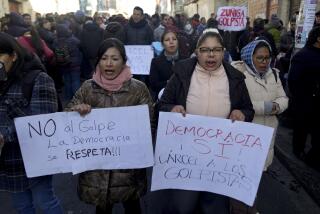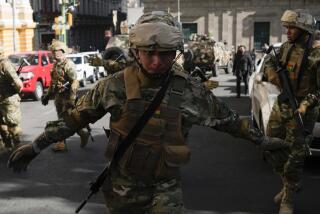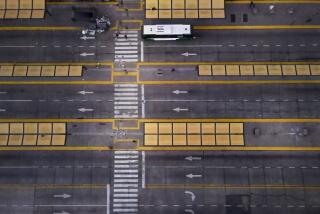Argentine Military Uprising Fails Only 2 Days Before Visit by Bush : South America: Army headquarters in capital is seized for a time. At least 11 are killed.
BUENOS AIRES — A rebellious faction of Argentine officers staged a bloody but unsuccessful anti-government uprising Monday, two days before a scheduled visit here by President Bush.
Rebels seized the army headquarters in downtown Buenos Aires, a block from the presidential palace, and three other military installations, battling troops loyal to the government throughout the day. The hostilities included heavy rifle fire, cannon shots and even aerial bombing of rebel tanks.
At least six military personnel were killed and an estimated 200 people were wounded, the local news agency DYN reported. It said five civilians were killed in a bus hit by a rebel armored vehicle. The wounded included four news reporters.
It was the fourth rebellion since April, 1987, by a movement of disgruntled nationalist officers nicknamed the Painted Faces for the camouflage grease paint they have used. But it was the first uprising since President Carlos Saul Menem took office in June, 1989, and Menem called it a coup attempt.
In a press conference Monday night, Menem said the government had foiled the uprising and dismantled the movement behind it.
“It is definitively concluded,” he said. “It is finished, and the Painted Faces are being finished, and all of this veritable clown act that has caused so much damage to the country.”
Menem, 60, said that “more than 50” rebels have been arrested. He indicated that they would be court-martialed for rebellion, which can bring the death penalty under Argentina’s military code.
“The president’s hand will not tremble, no matter what the penalty may be,” he said.
Monday’s revolt began before dawn, at about the same time that Bush was arriving in neighboring Brazil to begin a weeklong South American tour. Bush is scheduled to come to Argentina on Wednesday, and Menem said that the visit has been “totally ratified” since the uprising.
Argentina’s Painted Faces are right-wing officers with the rank of colonel and lower who complain that civilian government has reduced the living standards and prestige of the armed forces. They oppose many of Menem’s economic policies, including the privatization of government-owned enterprises such as the telephone company.
Hundreds of rebels, acting in coordinated operations, seized the army headquarters, the Patricios infantry regiment barracks in the capital’s eastern district of Palermo, a tank factory at Boulogne on the outskirts of the city, and part of a coast guard base.
Menem quickly imposed a state of siege and ordered military commanders to put down the uprising. Speaking Monday night, the president said the commanders obeyed his instructions to move forcefully and accept only unconditional surrender by the rebels.
Argentines watched the sporadic fighting live on television. Government offices and many stores closed early, and traffic was sparse during what is normally the evening rush hour. Otherwise city life was hardly disrupted outside the cordoned areas of conflict.
The first rebels to surrender were those who seized part of the coast guard installation in the city’s River Plate port. Two loyalist sailors were reportedly killed.
Fighting was heaviest at the Patricios infantry regiment, where rebels killed a colonel, a lieutenant colonel and a noncommissioned officer when they took over the compound. Fighting there continued into the afternoon, when government tanks moved into the compound and a 105-millimeter howitzer fired on the rebels.
Finally, about 100 rebels surrendered the compound, which was heavily damaged by the battle. Col. Enrique Baraldini, identified as the leader of the uprising, was among those taken prisoner.
Fighting was less severe at the Boulogne tank factory, where rebels retreating in an armored vehicle hit a bus, killing five civilians. In the province of Entre Rios, north of Buenos Aires, air force Canberra warplanes bombed a column of rebel tanks on a highway near the city of Gualeguaychu, damaging some of the tanks.
The body of a rebel colonel was found in a damaged tank, DYN said. No other rebellious activity was reported in the provinces.
During fighting at the downtown army headquarters, stray bullets hit the nearby presidential office building, called the Casa Rosada.
Loyal troops surrounded the massive army building. It was not clear how many floors the rebels held, but shooting issued periodically from the neoclassical structure. The rebels inside finally gave up shortly after 9 p.m.
The army did not report the total number of captured rebels, but it far exceeded the “more than 50” mentioned by Menem, who said that justice would be swift.
“The courts-martial already are functioning,” he said.
Asked if the rebels were followers of Col. Mohamed Ali Seineldin, the top leader of the Painted Faces who currently is under military detention, Menem said he did not know. But a rebel spokesman told reporters earlier in the day: “Within the army, we do not recognize any other legitimate authority than that of Col. Mohamed Ali Seineldin.”
The rebels claimed that their purpose was to bring changes in the army high command, but Menem insisted: “For the president of the nation, it was an attempted coup d’etat. “
The armed forces governed Argentina from March, 1976, to December, 1983. In the late 1970s, about 9,000 Argentines disappeared in a “dirty war” between security forces and leftist rebels.
Since 1983, military pressure has resulted in pardons for all but a few of the hundreds of officers jailed for violating human rights. Menem pardoned 39 of them and also pardoned more than 100 officers who took part in earlier rebellions.
Monday night he said there will be no more leniency for rebellious officers, but he repeated a promise to pardon former junta leaders imprisoned for human rights violations in the 1970s. They are former President Jorge R. Videla, the general who led a coup in 1976; former President Roberto E. Viola, the general who succeeded Videla, and former Adm. Emilio E. Massera, a member of Videla’s junta. Menem said the pardons are needed for “national reconciliation.”
BACKGROUND
Monday’s military uprising was Argentina’s fourth in four years. In April, 1987, Lt. Col. Aldo Rico and about 130 men briefly seized an infantry school. No one was killed. In January, 1988, Rico fled house arrest and, with about 200 followers seized a rural garrison. Surrounded by government troops, they surrendered. Again there were no deaths. In December, 1988, Col. Mohamed Ali Seineldin and scores of followers took over an army arsenal before giving up. One civilian was killed.
More to Read
Sign up for Essential California
The most important California stories and recommendations in your inbox every morning.
You may occasionally receive promotional content from the Los Angeles Times.










